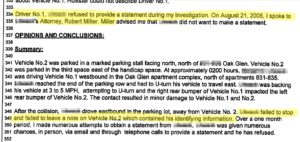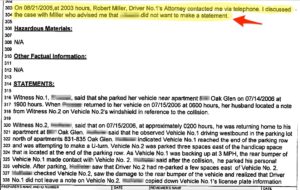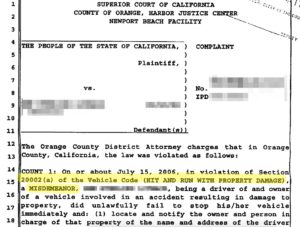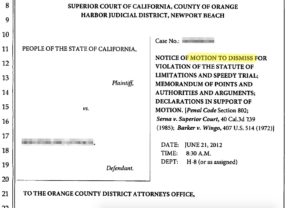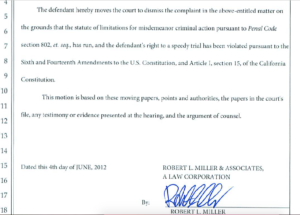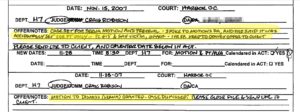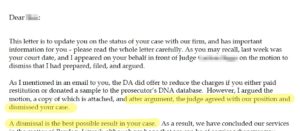Case Study: Orange County Hit and Run Dismissed
Case Study: Orange County Hit and Run Dismissed
This is another deep dive into the facts and the strategies that go into a dismissal of a criminal case. This is a Case Study: Orange County Hit and Run Dismissed out of the Harbor Justice Center in Newport Beach.
The Initial Hit and Run Facts
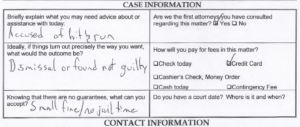
Exhibit 1: Client’s Intake Sheet with Our Law Firm. (Click to enlarge). Note that the client said that his goal of our representation is “Dismissal or Found Not Guilty”.
The client came into our office and needed help with police calling, trying to obtain a confession or admission, from an alleged hit and run incident in Orange County, California. As Orange County criminal defense attorneys, we listened to the client, and offered to assist by invoking the client’s fifth amendment privilege.
Our law firm has much experience with the Irvine Police Department, from professionally handling many Irvine DUI cases in court.
We contacted the police detective investigating the case, and indicated that our client would not be making any statement. The police would have to make the case based upon the facts and statements from others. There was no need for our client’s testimony in the case.
The Hit and Run Investigation
California’s Hit and Run Laws are contained in Vehicle Code section 20002(a). That code section requires a person involved in a collision to must stop, and exchange specific information (driver’s license information, contact information , and insurance information). As the law states:
20002 (a) The driver of any vehicle involved in an accident resulting only in damage to any property, including vehicles, shall immediately stop the vehicle at the nearest location that will not impede traffic or otherwise jeopardize the safety of other motorists. Moving the vehicle in accordance with this subdivision does not affect the question of fault.
The police received a call from a driver who witnessed a vehicle try to make a turn, back into another vehicle, stop, and then drive off. As the police report states, the driver “was backing his vehicle at 3 to 5 mph, attempting to U -turn and the right rear bumper of Vehicle 1 impacted the left rear bumper of Vehicle No. 2.” The police allege that the driver “failed to stop and failed to leave a note on Vehicle No. 2 which contained his identifying information.”
Exhibit 2: Police Report. (Click to enlarge). Note that the police note that Driver No. 1 “refused to provide a statement”, (as advised by his attorneys), and that it lists our Orange County Criminal Defense attorney Robert Miller as confirming that our client would not be making a statement.
The Right to Remain Silent in Hit and Run Cases
Exhibit 3: Police Report statement from criminal defense lawyer. (Click to enlarge).
As the police noted, they called our office in August, 2006, and advised that there would be no statements, admissions, or confessions forthcoming from our client.
Every person’s right against self-incrimination is spelled out in the Fifth Amendment to the U.S. Constitution, and also extends to the California state Constitution and laws in all local jurisdictions. When someone exercises this right, we often say that they “plead the Fifth.”
The Constitution grants this right quite simply: “[No person]…shall be compelled in any criminal case to be a witness against himself…” However, as with most other constitutional rights, it is subject to interpretation by the courts, which is a long subject to be detailed at another time.
The police agency in this case responded by coming to our client’s home, and impounding the vehicle for evidence. When that failed to provide a confession or admission, the client’s car was released to him.
Six Years Later: Finding Out Criminal Charges were Filed
Exhibit 4: Criminal Charges for Hit and Run filed against Client. (Click to enlarge).
Some point later, criminal charges were filed by the Orange County District Attorney, alleging Misdemeanor Hit and Run with property damage.
Unfortunately, our client was never notified of the filing of charges. Since there was never an arrest in the case, there was no promise to appear in court. The prosecutor’s office alleged that they send correspondence to an old address of the client’s, which he never received. Six years after the fact, the warrant for this client’s arrest came up at a very inconvenient time. Our client found out about the case when he was accepting a new career position, and traveling back into the country.
Our office did the arraignment in this case, and entered a plea of not guilty. We then obtained the reports and evidence prepared by the police and began planning a motion to dismiss in this case.
Hit and Run Motion to Dismiss
Exhibit 5: Motion to Dismiss Cover Page. (Click to enlarge).
Our office researched, wrote, served on the prosecutor’s office (the Orange County District Attorney’s Office). We filed our motion to dismiss with the court, who granted a hearing date.
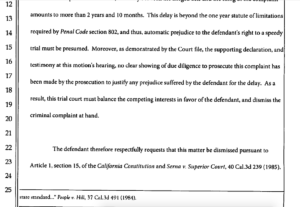
Exhibit 6: Motion to Dismiss Argument, and Legal Authority. (Click to enlarge).
The motion to dismiss in this case is informally called a Serna motion. A Serna motion alleges that the prosecutor failed to bring the case to justice within the statute of limitations. It asks the court to dismiss based upon that fact.
Exhibit 7: Motion to Dismiss Conclusion, and Signature. (Click to enlarge).
A “Serna motion” is a criminal motion to dismiss misdemeanor or felony charges because the defendant was denied his / her constitutional right to a speedy trial. This type of motion is based upon the United States Constitution (Sixth Amendment), and the California Constitution (Article 1, Section 15), and Penal Code section 1382.
Under the Serna case, a judge hearing the motion would balance the following four (4) factors:
- The length of the delay;
- The reason for the delay;
- Defendant’s assertion of the right to a speedy trial; and
- Prejudice to the defendant from the delay (this is presumed to exist if the delay is uncommonly long–which means over one (1) year in misdemeanor cases)
Argument took place in court, as the District Attorney’s Office opposed our motion. The judge considered the facts and made his decision.
Hit and Run Motion to Dismiss Granted
Exhibit 8: Court appearance notes showing motion to dismiss granted. (Click to enlarge).
The motion was granted, and the case was completely dismissed. We notified client by phone, and sent him written notice of his dismissal in our closing letter to our client:
Exhibit 9: Closing letter to client. (Click to enlarge).
Note that the image above tells the client that “a dismissal is the best possible result in this case. That is true, as it avoids a criminal record. It also avoids points on the driving record from the conviction, and avoids the fees, fines, and probation from even a reduction to a lesser charge.
The court’s records also showed the complete dismissal of the case:
Exhibit 10: Court records showing the dismissal of all charges. (Click to enlarge).
The court records on the case showed, after six years, that we met the client’s goal of dismissal or a not guilty. Needless to say, our client was extremely happy, and glad to be lifted of the burden of having this case hanging over his head.
Let us know if you found this case study: Orange County Hit and Run Dismissed helpful in seeing how the realistic defense of a case works.
Contact our Firm:
Contact our firm if you have questions about the possibility of having a hit and run, or any other charge, dismissed. We have experience and can help you win your case, as you can see by the above Case Study: Orange County Hit and Run Dismissed.


